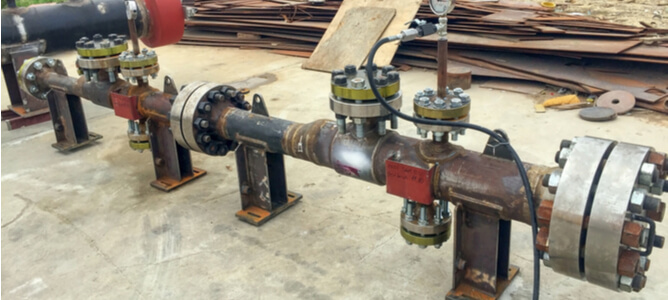
Guide to Pipeline Hydrostatic Testing
Pipeline systems are one of the safest methods for transporting fuel resources, but it’s crucial to ensure their integrity before they are put into service. Hydrostatic testing is a common method used to verify this integrity and ensure safety. This article provides an overview of pipeline hydrostatic testing, including its benefits, limitations, and requirements.
What is Hydrostatic Testing?
Hydrostatic testing is a method used to ensure the safety and structural integrity of pressure vessels like storage tanks, gas cylinders, plumbing systems, and pipelines. This technique involves applying water pressure to these vessels to check for leaks and assess their strength, helping to identify any weaknesses before they become problems.
How Does Hydrostatic Testing Work?
Hydrostatic testing is used to verify the integrity of pressure vessels. For pipelines, the standard procedure involves the following steps:
- Fill the pipeline with a liquid, mostly water, unless its material is incompatible with water.
- Apply pressure to the pipeline to bring it to its acceptable test pressure. This pressure is usually greater than the pipeline’s design working pressure.
- Hold the pressure for a required timeframe to examine the pipeline for possible leakages.
- Depressurize the pipeline after confirming that the test is complete and meets the specifications and industry standards.
Note that the vessel must have vents that allow air to escape as it is being filled with water. Additionally, fluorescent dyes can be applied to the testing fluid to aid inspection and analysis. After confirming that the pipeline holds at the acceptable test pressure, it can be certified safe to be deployed into service.

Common Applications of Hydrostatic Testing
Hydrostatic testing has a range of applications in the industrial sector. It’s used to check the integrity and guide the repair of:
- Gas, Water, and Fluid Piping Systems: Newly installed or modified piping systems for gases, water, and other fluids are tested to ensure they are free of leaks and capable of handling the pressures they will encounter in operation.
- Heat Exchangers: Hydrostatic testing is applied to heat exchangers to ensure they can manage the high pressures and temperatures involved in transferring heat between fluids without failing.
- Air Compressors and Distribution Systems: Testing is used to verify that air compressors and their associated storage and distribution systems are capable of operating safely under high pressure conditions.
- Fire Suppression Systems: Hydrostatic testing is crucial for fire suppression systems to ensure they are reliable and can effectively deliver the necessary pressure to combat fires when needed.
- Industrial Process Equipment: Equipment such as reactors, leads, and tanks used in industrial processes undergo hydrostatic testing to confirm their strength and safety under operating pressures.
In general, hydrostatic testing detects breaks, holes, or gaps in vessels that result during their fabrication from casting or welding. Some other possible flaws it can detect are gas pinholes, ductile tears, sand inclusion, and localized hard spots. Applications include flaw detection in industrial manufacturing, storage, and transportation equipment.
Benefits of Outsourcing Hydrostatic Testing
Outsourcing hydrostatic testing services has its benefits. The services of reputable hydrostatic pressure testing companies can be employed as they offer the following benefits:
- Proven years of experience on how to hydrostatic pressure test to industry’s and client’s standards.
- By owning advanced hydro testing equipment, they always comply with the Department of Transportation’s (DOT) specifications.
- Eliminates labor requirements related to procuring hydrostatic testing equipment.
- Saves time and money involved with running the tests by yourself and keeping the equipment’s certification up-to-date.
Limitations of Pipeline Hydrostatic Testing
Although pipeline hydrostatic testing has proven to be the most reliable, safest, and most common pressure testing method, it is not ideal for some systems, and it fails to detect some flaws. These two key limitations are discussed below.
Unsuitable for Certain Systems
Hydrostatic pressure testing is often not ideal for retesting existing systems. This is because the test requires removing or purging all contents from the vessels or systems, which means they must be taken out of service temporarily. This downtime can lead to reduced productivity, especially if you don’t have a backup system or vessel to take over during the test.
Inability to Detect Some Flaws
This pressure testing method is observed as being unable to detect subcritical flaws in a system. These flaws require the systems to be exposed to higher internal pressure ranges to be detectable and measurable. Since hydrostatic testing depends on visual inspection and sometimes expansion measurement to certify the equipment or system safe for use, subcritical flaws often go unnoticed or are worsened by the test.
Hydrostatic Test Requirements
The American Society of Mechanical Engineers (ASME) published the ASME B31.1 and ASME B31.3 codes to define hydrostatic testing requirements for process piping. These codes specify that the test pressure must be at least one and a half the design working pressure of the pipeline system at all times during the test. This specification can be altered only when the design and operating temperature are greater than the test temperature. In that case, a minimum allowable pressure can be evaluated following the codes.
NiGen Offers Hydrostatic Pressure Testing for Pipelines
At NiGen, we get how crucial it is to make sure your pipelines are safe and reliable. That’s why our hydrostatic pressure testing services are here to help you confirm their strength before they start running. With our top-notch equipment and skilled team, you can count on us to ensure your pipelines are up to the highest safety standards.
Contact us today to learn more about how our hydrostatic testing solutions can support your project’s success.

